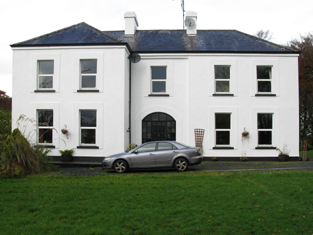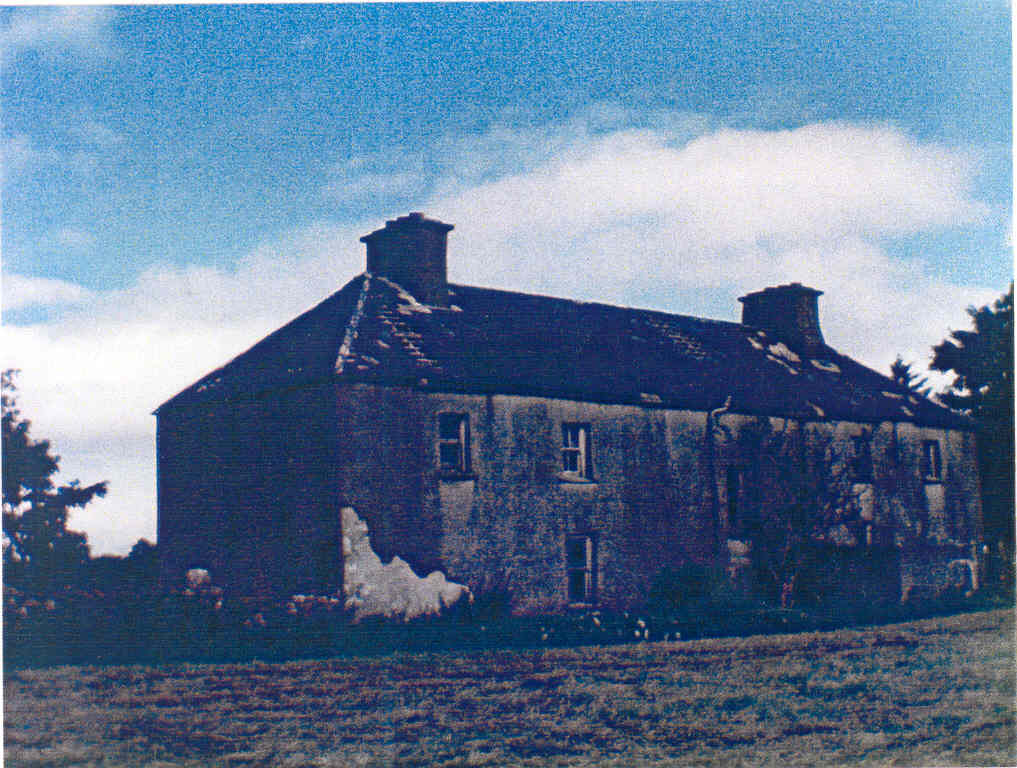Annagh
Houses within 15km of this house
Displaying 28 houses.
Houses within 15km of Annagh
Displaying 28 houses.
| House name | Description | |
|---|---|---|
| Mannin | The harper, Turlough O'Carolan, was a regular visitor to Mannin House and composed a number of tunes in honour of the Dillons and Betaghs. At the time of Griffith's Valuation the townland was owned by Margaret Mary "Beatty" and included a house valued at £5. The house still exists but is not inhabited. It was owned by a Mr Grogan in the 1940s. |

|
| Ballinvilla | The home of the Crean family in the 19th century. Ballinvilla was held in fee by Austin F. Crean at the time of Griffith's Valuation when it was valued at £7. This house no longer exists. | |
| Lugboy | Home of the Nolan family and the Nolan Ferrall family, this house no longer exists. The only feature still visible is a well in what was once part of the yard. |

|
| Holywell | At th time of Griffith's Valuation, John Burke Jnr. and Gerald Burke were jointly leasing this property from Hugh Burke, when the buildings were valued at £14. In 1786 Wilson refers to Holywell as a seat of Mr. Dillon. Some renovations were made to the house in 2005 by its current owner Eamon Healy. |

|
| Bekan | The exact location of the Burke's house in the village is not known. | |
| Tavraun House | A home of the O'Grady family in the 19th century, this house is still lived in and well maintained. In 1944 the Irish Tourist Association surveyor recorded Tavraun House as a plain, two-storey house, owned by Mr Walsh. Sir Henry Doran of the Congested Districts' Board lived in the house at the beginning of the 20th century. The family vault of the O'Gradys is in Urlaur Abbey. |

|
| Eden Park | Occupied by Joseph Brown at the time of Griffith's Valuation, when the property was valued at £3. Brown was leasing from Francis O'Malley. Mulloy writes that nothing remains of the house. | |
| Woodfield | At the time of Griffith's Valuation Francis R. O'Grady held the townland of Woodfield, which included an unoccupied house valued at £5. The house is labelled Woodfield House on both the 1st and 25-inch Ordnance Survey maps. Modern buildings exist at the site now though the ruins of some estate architecture is still visible. | |
| Ballyhowly | A Ruttledge family home in the 19th century, there is a lithograph of the house included in the sales advertisement of the Oranmore and Browne estate 1854. At the time of Griffith's Valuation, William Rutledge was leasing the property, valued at £10, from John Nolan Ferrall. Wilson describes it as "a country seat belonging to Henry Browne" in 1786. This house now offers farmhouse accommodation to guests. |

|
| Doonmacreena | In 1786 Wilson notes "Dunmacrene" as the seat of Mr. Blake. The sales rental of 1851 states that the old house at Doonmacreena was the residence of Mr Blake's ancestor 'now in ruins'. |

|
| Curraghleagh Lodge | The O'Moore sales rental of 1852 states that Isidore Bourke held Murneen North by a lease dated 1844, for 500 years. At the time of Griffith's Valuation he was leasing this property from Garret O'Moore when the house was valued at £30. This building is labelled Curraghleagh Lodge on the 25-inch Ordnance Survey map of the 1890s. A building much reduced in size is visible at the site. | |
| Ballygowan Cottage | A Prendergast home in the 19th century, now in an advanced state of disrepair. The property was held in fee by Richard Prendergast at the time of Griffith's Valuation when it was valued at almost £10. |

|
| Carrowneden | Jon Treston was leasing this house, valued at £4, from the O'Farrell estate at the time of Griffith's Valuation. A house is still extant at the site. | |
| Carrowbeg | Occupied by Patrick Sweeney in 1814 and by Richard O'Grady at the time of Griffith's Valuation. The house has been renovated and modernized and is still inhabited. |

|
| Castlegar | Occupied by Ignatius Kelly in 1814, by William T. Kelly at the time of Griffith's Valuation and by Edward Dale in 1906. In the 20th century it became a boys' secondary school. There is a lithograph of the house in the sale rental for Castlemagarret in the Public Record Office of Northern Ireland. | |
| Caher | Charles French was leasing the house at Caher, barony of Frenchpark, valued at £16, from Lord de Freyne's estate, at the time of Griffith's Valuation. Lewis also records the house as the residence of C. French in 1837. In the same year the Ordnance Survey Name books record Caher as a "dwelling house of three stories and slated". In the 1749 Census of Elphin F. Elwood was recorded as residing at Caher. By 1894 it was the residence of the Dowager Lady de Freyne. The building is still extant. | |
| Errit Lodge | Errit Lodge, valued at £12, was the residence of Fitzstephen French at the time of Griffith's Valuation. It is recorded as Lough Errit by Lewis in 1837 when the Ordnance Survey Name books describe it as " a well built house, two stories high and slated with detached offices". Slater refers to it as the seat of Hon. Charles French in 1894. In 1814 Errit is recorded as the residence of John Barlow. The Census of Elphin in 1749 also records it as a residence of W. Barlow. A modernised and derelict building now occupies the lakeshore site. |

|
| Glebe West | The Rev. Harlow Fleming was occupying the house valued at £6,at Glebe West, barony of Frenchpark, at the time of Griffith's Valuation. It was church property, being leased from the Bishop of Elphin. The house is still extant and apparently occupied. |

|
| Ballinlough | Rev. Robert Blundell was leasing a property valued at £16 at Ballinlough, parish of Kiltullagh, from the Sandford estate at the time of Griffith's Valuation. This appear to be the Glebe House. It is now a ruin. | |
| Willsborough | Henry Sampy was leasing a property valued at £3 10s + 155 acres at Willsborough, barony of Castlereagh, from the Sandford estate at the time of Griffith's Valuation. In 1814 this property was the residence of Walter Jordan. The site of Willsborough House is now occupied by the Community Centre and pitches of Michael Glaveys GAA Club. A memorial stone for a dog owned by Helen Sampey is preserved against the wall of the building. |

|
| Cashlieve House | Lewis describes a house at Cashla in the parish of Kiltullagh as a sporting lodge belonging to W.R. Wills in 1837. In the 1850s William Sandford owned a property valued at £24 at Cashlieve, barony of Castlereagh. The house now known as Cashlieve House was built in the later nineteenth century. |

|
| Lowberry | The Encumbered Estates' Sale notice of May 1856 indicates that the mansion at Lowberry had "formerly" stood in the demesne and recommends it as a "most desirable site for building". It is shown on the First Edition Ordnance Survey map but no buildings are recorded in the townland at the time of Griffith's Valuation. It is labelled "Lowberry House (in ruins)" on the 25-inch map of the 1890s. A portion of these ruins still remain at the site. | |
| Derry Lodge | At the time of Griffith's Valuation, Elizabeth Sandford was leasing a house at Derry, barony of Frenchpark, valued at £6 from the French estate. The house is described in the Ordnance Survey Name books of 1837 as "a good house, two stories high and thatched". The first edition of the Ordnance Survey map indicates a mill and a building described as "site of old iron works" close to the site. A modern building is located at Derry now. | |
| Cuillaun | Part of the Oranmore and Browne estate in the mid 19th century, occupied by Frenches, Brownes and by Edward Rush at the time of Griffith's Valuation, when the house was valued at £7. Now the home of the Donnellys. |

|
| Rockfort | Valued at £4 in the mid 19th century when it was occupied by Thomas Bourke who held from David Ruttledge. The Westport Estate Papers contain two 17th century maps of Levallyroe in the possession of Gerald Dillon and held from the Blakes. The Malones also had an interest in Levallyroe and Boleyboy. | |
| Dunmore Lodge | Melvin states that the Dunmore estate had been inherited by the Gores in the early eighteenth century and that Ralph Gore resided at Dunmore during that century. His mansion was subsequently in use as a barracks until it was destroyed during the Civil War in the early twentieth century. Marked on the Taylor and Skinner map of 1778 as the residence of the Earl of Ross and also noted as "the fine seat of the Earl of Ross" by Wilson in 1786. In 1814 Leet noted "Dunmore Lodge" as the residence of John Egan. | |
| Rockfield | Marked on the first edition Ordnance Survey map, this house was occupied by Henry French at the time of Griffith's Valution and was described as a herd's house. It was valued at £4 and was located on the estate of Lord Oranmore and Browne. Now derelict it was last occupied by the Dillon family. |

|
| Cloontreston | The notice advertising the sale of Michael Francis Treston's property at Cloontooa, barony of Clanmorris states that "the dwelling house with the offices, garden and demesne, known as Cloontreston, is in fair order and condition, suitable as a residence for a gentleman". At the time of Griffith's Valuation the townland was owned by John Treston who also held a herd's house there. The house is labelled Cloontreston on twentieth century maps. Buildings are still extant at the site. |

